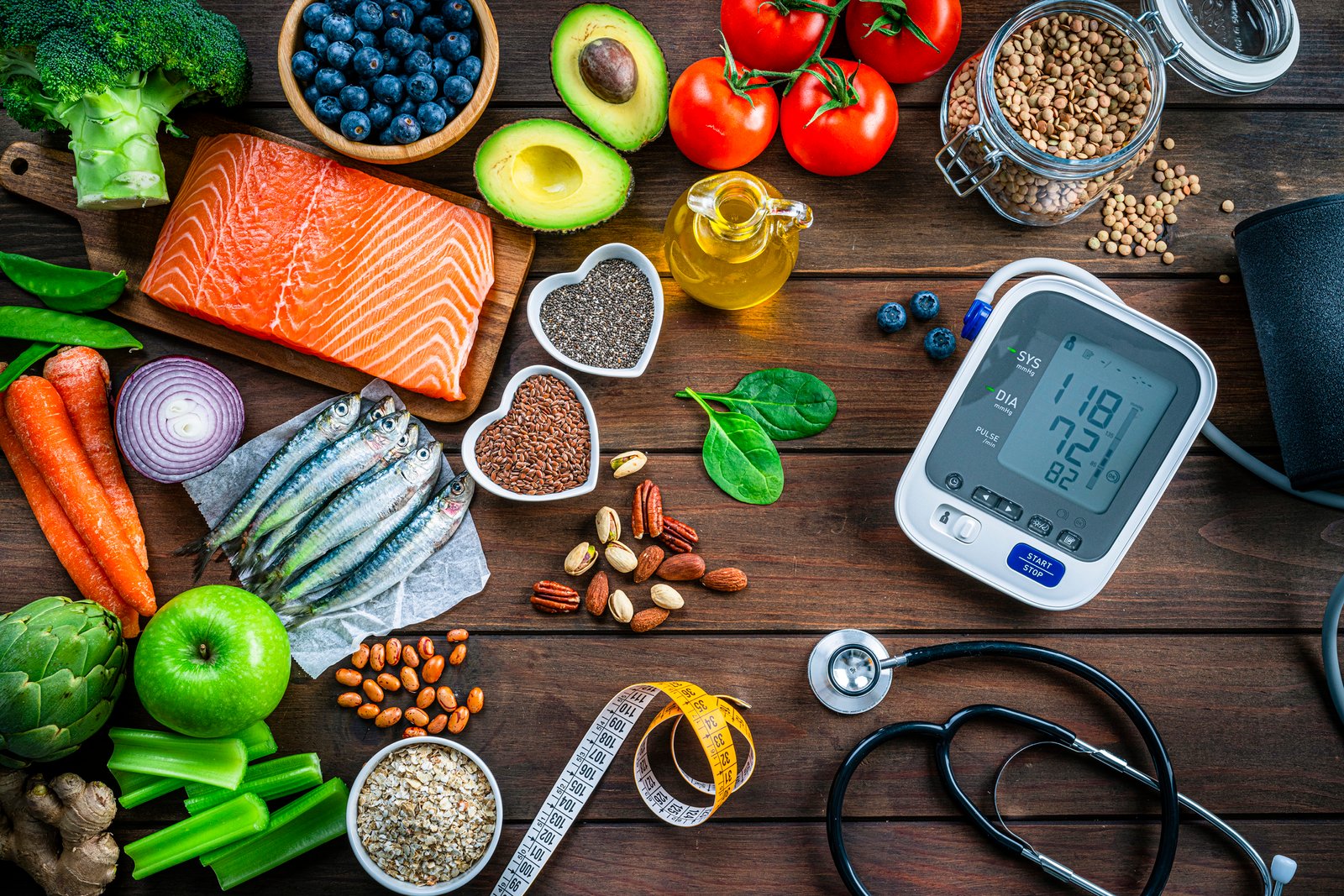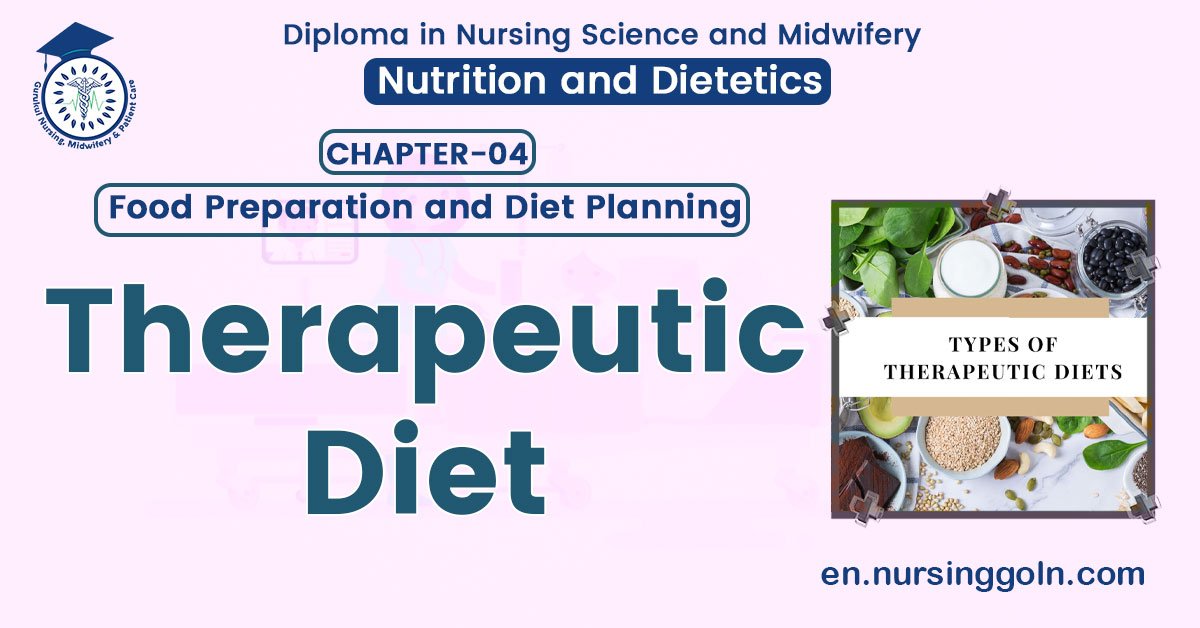Concept about Therapeutic diet – This book covers the entire syllabus of “Nutrition and Dietetics” prescribed by BNMC-for all Diploma in Nursing Science and Midwifery students. We tried to accommodate latest information and topics. This book is examination friendly setup according to the teachers’ lectures and examination’s questions. At the end of the book previous university questions are given. We hope in touch with the book students’ knowledge will be upgraded and flourished. The unique way of presentation may make your reading of the book a pleasurable experience.

Concept about Therapeutic diet
Therapeutic Diet:
Therapeutic diet is the diet requirement of patients who are suffering with diseases. While planning the diet following information to be kept in mind i.e. causes of disease, duration of illness, food habits of the patient, effect of the illness of food acceptance, psychological and emotional factors.
(Ref: Onila Salin’s Essential nutrition/1/128)
Factors to Be Considered in Planning Therapeutic Diet:
The normal diet may be modified –
1. To provide change in consistency as in fluid and soft diet.
2. To increase or decrease the energy needs.
3. To increase or decrease one or more amounts of nutrients e.g. in case of high protein diets or sodium and potassium restricted diets, restricted fat diet, etc.
4. To increase or decrease bulk high or low fibre diets.
5. To include or exclude certain allergic foods.
6. To modify the intervals of feeds [like in tube feeds etc].
(Ref: Molly Sam’s A text book of Nutrition for Nurses/24/155-156)
Diet Therapy:
Diet therapy is concerned with the modification of normal diet to meet the requirements of the sick individual.
(Ref: Sheilla John’s/1/211)
[OTHER DEFINITIONS – NICE TO KNOW]
Diet therapy means use of diet (food and drink) not only in the care of the sick, but also in the prevention of disease and maintenance of health.
Objectives of Therapeutic Diet:
1. To correct dietary deficiencies.
2. To maintain the patient in good nutrition status.
3. To formulate diet to meet the needs of the patient.
4. To educate the patient and his family.
(Ref: Onila Salin’s Essential nutrition/1/128)
Purposes of Diet Therapy:
1. To maintain a good nutritional status.
2. To correct nutrient deficiencies this may have occurred due to the disease.
3. To plan and provide a diet that is most suited to the disease condition.
4. To adjust the food intake to the body’s ability to metabolize the nutrients in sickness
5. To bring about changes in body weight whenever necessary.
(Ref: Sheilla John’s/1/211)

Types of Special Diet:
Diet will have to be modified with regard to the consistency to suit the needs of the patient. Diet suitable for feeding this include-
1. Soft diet.
2. Clear fluid diet.
3. Full fluid diet.
Types of Diet:
There are several types of diet.
1. Normal food: An average patient whose appetite is normal is given normal food. Fried and highly seasoned foods are not given to patients.
2. High diet: It is cooked simply, without fat; gas forming foods are also avoided.
3. Soft diet: It contains food which requires little chewing and contains no fibre or no seasoning. These foods are given to people with gastro intestinal disorders.
4. Liquid diet:
- Full liquid diet: Soups, puddings, custards, cooked cereals, milk.
- Clear diet: Water, tea, lemon, coffee, juice and beverage.
- Bland diet: Full liquid diet excepting coffee, tea, colas and soups.
5. Therapeutic diet:
- Diabetic diet.
- Sippe’s diet.
- Fat free diet.
- High caloric diet.
- Low caloric diet.
(Ref: Alphonsa Jacob/Vol-1/139)
Full Fluid Diet
Indications of Full Fluid Diet:
1. Postoperative phase when progressing from clear liquids to solid foods.
2. Acute gastritis and infections.
3. Following oral surgery or plastic surgery of face or neck area.
4. In chewing and swallowing dysfunction.
5. In oesophageal or stomach disorders causing intolerance to solid food intake.
(Ref: Sheilla John’s/1/213)
Full fluid diets bridges the gap between the clear fluid and soft diet. These consist of inclusion of eggs, milk, cereal, porridges, ganjis or gruels, vegetable-or chicken or mutton soup’ fruit milk etc. This type of diet will meet the minimum requirement of all protein, calories, vitamins and minerals. It is free from cellulose and irritating condiments and spices.
This diet can be properly planned and made nutritionally adequate for maintenance requirements. If this diet used for more than two days, then a high protein, high calorie supplement may be necessary. This diet is given in between a clear liquid diet and soft diet, at the interval of 2-4 hours. The average nutritional composition of this diet is 1200 kcal and 35 g protein.
(Ref: Sheilla John’s/1/217)

Liquid Diet/Clear Fluid
Indications of Clear Liquid Diet:
1. Preoperative period – like before bowel surgery
2. Postoperative phase e.g., in the initial recovery phase after abdominal surgery or after a period of intravenous therapy.
3. Acute illness and infections as in acute gastro intestinal disturbances such as acute gastroenteritis, when fluid and electrolyte replacement ii desired to compensate for losses from diarrhea.
4. As the first step in oral alimentation of a nutritionally debilitated person.
5. In temporary food intolerance.
6. Prior to colonoscopic examination
Clear liquid diet is a temporary diet of clear liquids without residue and is non-stimulating, non- irritating and non-gas forming. Small amounts of fluids (usually 30-60 ml) are served at frequent intervals, 2 hourly to replace fluid and electrolytes lost and also to relieve thirst. Being composed mainly of water, carbohydrates and some electrolytes. A clear fluid diet can normally provide only 400-500 keal, 5 g protein, negligible amount of fat and 100-1209 of carbohydrates.
Clear fluids are prescribed for patient with marked intolerance; an acute illness may produce nausea, vomiting, anorexia, distention and diarrhoea. The clear fluids are usually used for 1 or 1 or 2 days till the patient is able to retain and digest a more liberal liquid diet clear fluid diets are meant to provide very few calories and make, up the water loss in the body.
(Ref: Sheilla John’s/P/218)
Soft Diet
Soft diet is one of the most frequently used routine diets. It bridges the gap between acute illness and convalescence. It is used in acute infections, following surgery and for, patients who are unable to chew soft diet is used as a transitional diet between full fluid and normal diet.
Soft diet is nutritionally adequate. It is soft in consistency, easy to chew, made up of simple, easily digested foods, containing limited fiber and does not contain rich or highly flavored foods. The average soft diet supplies around 1800 kcal and 50 g protein.
(Ref: Sheilla John’s/1/214)
Indication of Soft Diet:
1. While progressing from full fluid from full fluid diet to general diet.
2. During postoperative phase when patient is unable to tolerate normal diet. ob jud
3. Gastrointestinal problem e.g., diarrhea.
4. Convalescence.
5. General debilitation & inadequate dentition.s
6. Transition from acute phase of illness to convalescence
7. Acute infection.
(Ref: Sheilla John’s/1/226)
Characteristics of Soft Diet:
The soft diet is:
1. Made of simple foods.
2. Easily digestable.
3. Contains no fibre.
4. Near to a normal diet.
5. Not highly spiced or seasoned
6. It is nutritionally adequate when planned on the basis of normal diet.day
(Ref: Molly Sam’s A text book of Nutrition for Nurses/24/118)
Dietary Goals:
All countries should develop a national nutrition and food policy setting out “dietary goals” for achievement. The dietary goals (prudent diet) recommended by the various Expert Committee of WHO are as below:
1. Dietary fat should be limited to approximately 15-30 per cent of total daily intake.
2. Saturated fats should contribute no more than 10 per cent of the total energy intake; unsaturated vegetable oils should be substituted for the remaining fat requirement.
3. Excessive consumption of refined carbohydrate should be avoided; some amount of carbohydrate rich in natural fibre should be taken.
4. Sources rich in energy such as fats and alcohol should be restricted.
5. Salt intake should be reduced to an average of not more than 5 g per day: (salt intake is more in tropical countries.
6. Protein should account for approximately 10-15 per cent of the daily intake.
7. Junk foods such as colas, ketchups and other foods that supply empty calories should be reduced.
(Ref: K. Park/24/609)

Dietary Fiber
Dietary fibre is the remnants of the edible parts of plants and analogous carbohydrates that are resistant to digestion and absorption in the human small intestine with complete or partial fermentation in the human large intestine.
Functions of Dietary Fiber:
1. Reduce incidence of coronary heart disease.
2. Reduce post-prandial glucose level in blood.
3. Reduce cholesterol level in circulation.
4. Reduce the risk of gall stones, diabetes, coronary hypertension and bowel disease including cancer.
5. Dietary fibres have a role in weight reduction.
Disadvantage of Dietary Fiber:
(Ref: K. Park/23/614)
Dietary fibres tend to bind some fat soluble vitamins and elements like iron and zinc and reduce their bioavailability.
(Ref: K. Park/23/614)
Read more:
